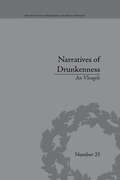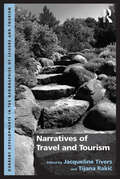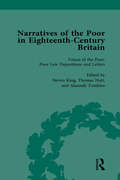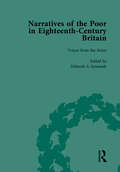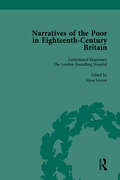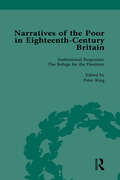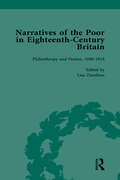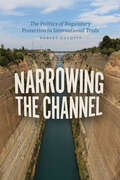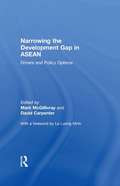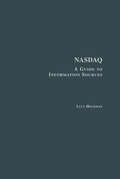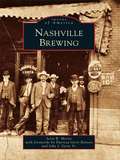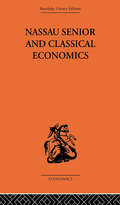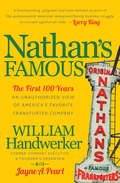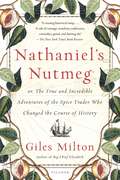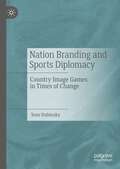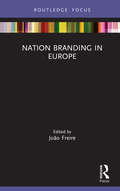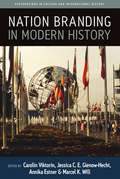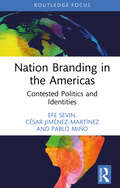- Table View
- List View
Narratives of Drunkenness: Belgium, 1830–1914 (Perspectives in Economic and Social History #25)
by An VleugelsFocusing on Belgium from the mid-nineteenth century until the First World War, Vleugels presents a study of the drunkard in society.
Narratives of Travel and Tourism (Current Developments In The Geographies Of Leisure And Tourism Ser.)
by Tijana RakicTravel and tourism 'stories' have been told and recorded within every culture, in every period of oral and written history, and across the breadth of the fact/fiction continuum. Taking two broad themes as its starting point - travellers and their narratives, and place narratives in travel and tourism - the book has a deliberately wide scope, with different chapters addressing the subject through various relevant 'lenses' and in relation to a number of different contexts. The narratives discussed include both historical and contemporary, as well as 'real-life' and fictional, narratives contained within travel writing, travel and tourism stories and different types of media. In relation to the principal themes of the book, some chapters also explore the importance of collecting memorabilia and image making in the recording, remembering, writing, telling or disseminating of stories about travel and tourism experiences and some examine the ways in which travel and tourism narratives may construct and reinforce personal, collective and place identities. The whole book is marked by an over-arching concern for narrative interpretation as a means of understanding, and providing a new perspective on, travel and tourism.
Narratives of the Poor in Eighteenth-Century England Vol 1
by Peter King Steven King Alysa Levene Alannah Tomkins Lisa Zunshine Thomas Nutt Deborah A SymondsPresents narratives of the poor in eighteenth-century Britain. This collection covers the period from the early eighteenth century through to the Poor Law Amendment Act of 1834 and includes transcriptions of hand-written first-hand representations of poverty to poor law officials.
Narratives of the Poor in Eighteenth-Century England Vol 2
by Peter King Steven King Alysa Levene Alannah Tomkins Lisa Zunshine Thomas Nutt Deborah A SymondsPresents narratives of the poor in eighteenth-century Britain. This collection covers the period from the early eighteenth century through to the Poor Law Amendment Act of 1834 and includes transcriptions of hand-written first-hand representations of poverty to poor law officials.
Narratives of the Poor in Eighteenth-Century England Vol 3
by Peter King Steven King Alysa Levene Alannah Tomkins Lisa Zunshine Thomas Nutt Deborah A SymondsPresents narratives of the poor in eighteenth-century Britain. This collection covers the period from the early eighteenth century through to the Poor Law Amendment Act of 1834 and includes transcriptions of hand-written first-hand representations of poverty to poor law officials.
Narratives of the Poor in Eighteenth-Century England Vol 4
by Peter King Steven King Alysa Levene Alannah Tomkins Lisa Zunshine Thomas Nutt Deborah A SymondsPresents narratives of the poor in eighteenth-century Britain. This collection covers the period from the early eighteenth century through to the Poor Law Amendment Act of 1834 and includes transcriptions of hand-written first-hand representations of poverty to poor law officials.
Narratives of the Poor in Eighteenth-Century England Vol 5
by Peter King Steven King Alysa Levene Alannah Tomkins Lisa Zunshine Thomas Nutt Deborah A SymondsPresents narratives of the poor in eighteenth-century Britain. This collection covers the period from the early eighteenth century through to the Poor Law Amendment Act of 1834 and includes transcriptions of hand-written first-hand representations of poverty to poor law officials.
Narrowing the Channel: The Politics of Regulatory Protection in International Trade (Chicago Series on International and Domestic Institutions)
by Robert GulottyWhile large, multinational corporations have supported the removal of tariffs, behind the scenes these firms have fought for protection in the form of product regulations, including testing, labeling, and registration requirements. Unlike tariffs, these regulations can raise fixed costs, excluding smaller firms from the market and shifting profits toward global giants.Narrowing the Channel demonstrates that globalization and globalized firms can paradoxically hinder rather than foster economic cooperation as larger firms seek to protect their markets through often unnecessarily strict product regulations. To illustrate the problem of regulatory protectionism, Robert Gulotty offers an in-depth analysis of contemporary rulemaking in the United States and the European Union in the areas of health, safety, and environmental standards. He shows how large firms seek regulatory schemes that disproportionately disadvantage small firms. When multinationals are embedded in the local economy, governments too have an incentive to use these regulations to shift profits back home. Today, the key challenge to governing global trade is not how much trade occurs but who is allowed to participate, and this book shows that new rules will be needed to allow governments to widen the benefits of global commerce and avoid further inequality and market concentration.
Narrowing the Development Gap in ASEAN: Drivers and Policy Options
by David Carpenter Mark McGillivrayAn important part of the vision of the Association of Southeast Asian Nations (ASEAN) is to ensure that the benefits of development and economic integration are equitably shared by all member states and their citizens. ASEAN’s work therefore aims to narrow the development gap between ASEAN member states (Indonesia, Malaysia, the Philippines, Singapore, Thailand, Brunei Darussalam, Myanmar, Cambodia, Laos and Vietnam) and between sub-regions within ASEAN. Written by a team of internationally recognised experts in development economics, this book communicates the latest findings on narrowing the development gap in a practical, policy-relevant way, in a format that can influence decision makers within ASEAN member states and international donors. There have been significant development achievements in many ASEAN countries over the last 20 years, but the ASEAN region continues to be characterised by significant development gaps, particularly in income. Gaps in development achievement are also seen at the regional and sub-national levels. This book offers a better understanding of development gaps, as they exist in 2012, and provides important context that can inform the strategic needs of decision makers in the ASEAN region. Due to improvements in conceptualising and measuring well-being, including through the use of multidimensional indicators, this book gives policy makers and scholars in development economics, development policy and Asian studies well-grounded insights into the nature of the development gaps within and between ASEAN countries as well as high-level policy advice on those interventions that can contribute to a narrowing of the development gap.
Nascent Platform Strategy: Overcoming the Chicken-or-Egg Dilemma
by Andy Wu David R. Clough Sasha KaletskyThis note provides a framework for addressing the classic chicken-or-egg dilemma facing entrepreneurs launching nascent multi-sided platforms. There are several conditions that lead to a difficult chicken-or-egg problem: strong network effects, high multi-homing costs, limited differentiation, and high other barriers to entry. To overcome this challenge and create competitive advantage by reaching critical scale in network size, there are three categories of solutions to the problem: increasing value, decreasing cost, or subsidizing value for the platform participants. For a multi-sided platform, there are also dynamic considerations for addressing whether to stage one side of the platform first or build both simultaneously.
Nasdaq: A Guide to Information Sources (Research and Information Guides in Business, Industry and Economic Institutions)
by Lucy HeckmanNASDAQ brings together, in one volume, a comprehensive annotated bibliography of books, theses and dissertations, US Government reports, journal articles, journals and serials, indexes and abstracts, databases, and websites from 1939 to May 2000.
Nashton Partners and its Search Fund Process
by Richard S. Ruback Royce YudkoffNashton Partners was a search fund founded by two HBS MBA's that raised $500,000 to finance a search for a company that they could purchase and then run for the next five to ten years. The case examines the search fund structure, the two-year search, and two potential acquisitions.
Nashton Partners and its Search Fund Process
by Richard S. Ruback Royce YudkoffNashton Partners was a search fund founded by two HBS MBA's that raised $500,000 to finance a search for a company that they could purchase and then run for the next five to ten years. The case examines the search fund structure, the two-year search, and two potential acquisitions.
Nashua River Capital Management
by Aldo Sesia Samuel G. HansonInvestment manager Eliza Baena confronts an apparent convertible bond arbitrage opportunity when she notices a narrowing spread between two Boston Properties (BXP) bonds, one a convertible bond and the other a straight bond, in the wake of the 2008 Lehman bankruptcy. Baena must decide if there is an opportunity, how to structure a trade to exploit it, and how much of her fund's capital to allocate. Case exposition includes descriptions of basic financing arrangements that support arbitrage strategies, such as rehypothecation and margin lending.
Nashua River Capital Management
by Aldo Sesia Samuel G. HansonInvestment manager Eliza Baena confronts an apparent convertible bond arbitrage opportunity when she notices a narrowing spread between two Boston Properties (BXP) bonds, one a convertible bond and the other a straight bond, in the wake of the 2008 Lehman bankruptcy. Baena must decide if there is an opportunity, how to structure a trade to exploit it, and how much of her fund's capital to allocate. Case exposition includes descriptions of basic financing arrangements that support arbitrage strategies, such as rehypothecation and margin lending.
Nashville Brewing (Images of America)
by Scott R. Mertie Patricia Gerst Benson John J. Gerst Sr.Known for country music, antebellum homes, the Parthenon, and Civil War battlefields, Nashville also has a rich brewing history that spans 100 years. Several breweries were established in the late 1800s, but the William Gerst Brewing Company alone endured into the 20th century and even survived Prohibition. Once one of the largest breweries in the South, Gerst brewed its last batch in 1954, leaving Nashvillians unable to enjoy locally brewed beer until the dawn of the recent microbrewery revolution. Nashville Brewing offers readers a pictorial account of the William Gerst Brewing Company-an important but almost forgotten part of Nashville history.
Nassau Senior and Classical Economics (Routledge Library Editions)
by Marian Bowley"one of the best contributions to the history of economic thought during recent years" P. M. Rosenstein-Rodan Nassau Senior is one of the most significant economists in the classical tradition. This study is based both on his unpublished and published lectures and writings. Part 1 illustrates Senior's outstanding contribution in synthesizing the various developments of Adam Smith's theories that took place during the first part of the nineteenth century. Part 2 examines Senior's opinions and influence on social and economic policy, in particular his connection with the passing of the Poor Law Amendment Act of 1834.
Nasty Gals Do It Better
by Matthew Shaffer David J. Collis Ashley Hartman Diane ChangIn 2006, Sophia Amoruso started Nasty Gal, an eBay boutique selling vintage clothes. With a strong sense of style and personality, Amoruso poured herself into building the brand and developing relationships with her customers - typically the slightly edgy 18-24 year old. The company had grown since that time into a multi-category retailer, expanding into third party clothing, accessories and its own private label. Its explosive growth was one of the biggest stories in e-commerce, especially when the retailer attracted $50m in investment from Index Ventures, a top VC firm that funded other successful retailers such as Net-a-Porter and Etsy, in 2013. Yet, with a cash infusion, plans for a brick and mortar store, an ever-growing e-commerce site, and fierce competition, Amoruso wondered what opportunity to tackle next. Should she concentrate on product line expansion into lingerie, swimwear, cosmetics and fragrances? How would a brick and mortar store impact the focus of the company or its ability to develop customized web sites for overseas markets? How would she maintain the detail and attention she had put into so many aspects of the company as Nasty Gal grew? As Sophia's time was limited and management resources were already spread thin to sustain the existing site's growth, what was the best way forward?
Nasty Gals Do It Better
by Matthew Shaffer David J. Collis Ashley Hartman Diane ChangIn 2006, Sophia Amoruso started Nasty Gal, an eBay boutique selling vintage clothes. With a strong sense of style and personality, Amoruso poured herself into building the brand and developing relationships with her customers - typically the slightly edgy 18-24 year old. The company had grown since that time into a multi-category retailer, expanding into third party clothing, accessories and its own private label. Its explosive growth was one of the biggest stories in e-commerce, especially when the retailer attracted $50m in investment from Index Ventures, a top VC firm that funded other successful retailers such as Net-a-Porter and Etsy, in 2013. Yet, with a cash infusion, plans for a brick and mortar store, an ever-growing e-commerce site, and fierce competition, Amoruso wondered what opportunity to tackle next. Should she concentrate on product line expansion into lingerie, swimwear, cosmetics and fragrances? How would a brick and mortar store impact the focus of the company or its ability to develop customized web sites for overseas markets? How would she maintain the detail and attention she had put into so many aspects of the company as Nasty Gal grew? As Sophia's time was limited and management resources were already spread thin to sustain the existing site's growth, what was the best way forward?
Nathan's Famous: An Unauthorized View of America's Favorite Frankfurter Company
by Jayne A. Pearl William Handwerker&“A heartwarming, poignant and even-handed account of the quintessential American immigrant/family business struggle to succeed against all odds&” (Larry King). Nathan&’s Famous chronicles the history and business strategies of company founder Nathan Handwerker that led to the success of an iconic international brand and two of America&’s most loved foods: the Nathan&’s Famous Frankfurter and Crinkle-cut French Fries. Brimming with photos of historic Coney Island, New York, Nathan&’s Famous restaurants, and intimate family memories of author, former company Senior Vice president and grandson William Handwerker, Nathan&’s Famous details entrepreneurial spirit, business lessons, dramatic corporate missteps and growth. William includes insights into three generations of the Handwerker family, beginning with the founder&’s early life, growing up in extreme poverty in Galicia, Poland, as well as his own sons and grandson who contributed to expanding geographic locations, menu and the overall brand. Nathan&’s may have started as a small hot dog stand in 1916, but by sticking to his philosophy to &“give &’em and let &’em eat,&” he was able to beat his competition by providing top quality food at low prices. Nathan&’s Famous reveals the successes, trials and tribulations of growing Nathan&’s original vision into the international frankfurter corporation it is today.
Nathaniel's Nutmeg: Or, The True and Incredible Adventures of the Spice Trader Who Changed the Course of History
by Giles MiltonA true tale of high adventure in the South Seas. The tiny island of Run is an insignificant speck in the Indonesian archipelago. Just two miles long and half a mile wide, it is remote, tranquil, and, these days, largely ignored. Yet 370 years ago, Run's harvest of nutmeg (a pound of which yielded a 3,200 percent profit by the time it arrived in England) turned it into the most lucrative of the Spice Islands, precipitating a battle between the all-powerful Dutch East India Company and the British Crown. <p><p> The outcome of the fighting was one of the most spectacular deals in history: Britain ceded Run to Holland but in return was given Manhattan. This led not only to the birth of New York but also to the beginning of the British Empire. Such a deal was due to the persistence of one man. Nathaniel Courthope and his small band of adventurers were sent to Run in October 1616, and for four years held off the massive Dutch navy. Nathaniel's Nutmeg centers on the remarkable showdown between Courthope and the Dutch Governor General Jan Coen, and the brutal fate of the mariners racing to Run-and the other corners of the globe-to reap the huge profits of the spice trade. Written with the flair of a historical sea novel but based on rigorous research, Giles Milton's Nathaniel's Nutmeg is a brilliant adventure story by a writer who has been hailed as the "new Bruce Chatwin"
Nation Branding and Sports Diplomacy: Country Image Games in Times of Change
by Yoav DubinskyThis book critically discusses the role of sports in nation branding and public diplomacy during the years 2020 and 2022, as the world was going through a global pandemic and health, economic, social, and political crises. The book argues that the use of sports for nation branding and public diplomacy goals is not new, but the changes the world went through required nations, places, communities, and individuals to modify and adapt the ways they use sports for country image purposes. After discussing global changes, the book outlines the theoretical frameworks of nation branding and public diplomacy, and discusses their manifestations through the evolution of the FIFA World Cup, the postponed Tokyo 2020 Olympic Games, the role of Title IX in American sports, the European Super League, the Oregon22 World Athletics Championships, the emergence of sport-tech diplomacy, and though the role of sports and the global order in an ever-changing world.
Nation Branding in Europe (Routledge Focus on Nation Branding)
by João FreireThis book provides an explanation of nation branding theory and practice within the European context, exploring how countries build and manage their reputations globally. Each chapter focuses on a specific European country, selected from a cross-section of large, medium-sized and small countries to provide a breadth of cases from across the continent. The chapters are written from a wide range of academic and practitioner perspectives. Nation Branding in Europe is valuable supplementary reading for advanced undergraduate, postgraduate and doctoral students interested in nation branding and will appeal to students from marketing, communications, and international relations disciplines. Outside of academia, the book will be of interest to those working in the areas of public diplomacy and strategic communications, as well as public relations and branding practitioners involved in designing nation branding campaigns.
Nation Branding in Modern History (Explorations in Culture and International History #9)
by Carolin Viktorin Jessica Gienow-Hecht Annika Estner Marcel K. WillA relatively recent coinage within international relations, “nation branding” designates the process of highlighting a country’s positive characteristics for promotional purposes, using techniques similar to those employed in marketing and public relations. Nation Branding in Modern History takes an innovative approach to illuminating this contested concept, drawing on fascinating case studies in the United States, China, Poland, Suriname, and many other countries, from the nineteenth century to the present. It supplements these empirical contributions with a series of historiographical essays and analyses of key primary documents, making for a rich and multivalent investigation into the nexus of cultural marketing, self-representation, and political power.
Nation Branding in the Americas: Contested Politics and Identities (Routledge Focus on Nation Branding)
by Efe Sevin César Jiménez-MartÍnez Pablo MiñoNation Branding in the Americas: Contested Politics and Identities provides an overview of nation branding in the Americas, an often neglected continent(s) in debates about the creation, dissemination and management of national images.Drawing on insights from promotional cultures, nationalism, geopolitics, media and communication, as well as their own research, the authors look at national promotion experiences in twelve countries - Canada, the United States, Mexico, Costa Rica, Colombia, Ecuador, Peru, Bolivia, Brazil, Uruguay, Argentina and Chile - , examining how these cases relate to broader challenges and commonalities, such as the relationship between nation branding and stereotypes, invisibility, heritage or internal contradictions. Nation Branding in the Americas: Contested Politics and Identities is an important contribution to the study of practices and concepts such as nation branding, public diplomacy, soft power, and strategic communication. It highlights the multifaceted nature of nation branding, and how this can be used to perpetuate local and global hierarchies, legitimize the agendas of specific governments, and discipline the inhabitants of a nation, but also become a venue for people to negotiate and communicate the kind of society they want to be. The book will therefore be of interest for undergraduate, postgraduate, and doctoral students specialized in marketing, media and communication, and international relations. It will also appeal to professionals in public diplomacy, strategic communication, public relations, and branding, offering a broad overview to the practice and discussion of national promotion in an increasingly contested and cacophonic global communication environment.
